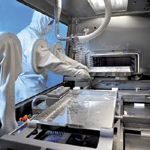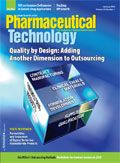In the Spotlight January 2010
Editors' Picks of Pharmaceutical Science & Technology Innovations
A successful pharmaceutical manufacturer always reevaluates its processes to see how they might be made more efficient. Automated equipment, which often performs tasks more quickly and accurately than humans do, can help a company improve its operations. This month's products show how automation can assist quality-control and manufacturing processes. Telstar's new system reduces the risk of product contamination during lyophilization. An instrument from RTS life sciences can free scientists' time for more sophisticated tasks. Copley Scientific's cup coater enhances quality-control procedures.
System automates lyophilization
Telstar (Barcelona) has added a unit to its LyoGistics series of automated loading systems that is designed for the commercial-scale production of freeze-dried active ingredients. The freeze-drying system automatically loads product trays into the lyophilizer without sliding them across the surface of the chamber shelves. The system also fills trays with liquid product and removes lyophilized product using a vacuum system after the drying process is complete.

LyoGistics system Telstar www.etelstar.com
The setup incorporates a containment isolator between the product and the operator that limits operator exposure to less than 1 µg/m3 during an eight-hour shift. After freeze-dried product has been unloaded, product trays are stored on two independent Tray Storage Carts connected to each side of the main isolator chamber. The isolator system can be broken down easily into modules for inspection and maintenance, according to the company. The product also includes decontamination and cleaning systems.
Instrument modified to handle larger samples
RTS Life Science (Manchester, England) introduced two new adaptors for its RTS SolidPrep instrument for tablet and capsule homogenization. The adapters enable the instrument to work with 80- and 120-mL tubes. It can now handle as much as 100 mL of solvent with existing methods that use standard 50- and 100-mL glassware. Operators can fit the adaptors easily and change them without using tools.

SolidPrep instrument RTS Life Science www.rtslifescience.com
SolidPrep tubes have lids that are leak-proof and easy to seal, thus facilitating tablet homogenization. The polypropylene tube containers and lids are compatible with common analytical solvents and extraction media.
Coater aids particle-size measurement
Copley Scientific (Nottingham, England) has introduced an automatic cup coater for the Next Generation Impactor (NGI), which measures the aerodynamic size of drug particles for inhalation. The unit is designed to provide reproducible coating and improve particle-size measurement accuracy by reducing particle bounce within the NGI.

Automatic cup coater Copley Scientific www.copleyscientific.co.uk
The instrument automatically dispenses a sticky cup-coating solution into all eight NGI cups simultaneously. The coater recovers excess coating solution and returns it to the storage reservoir. The coater's fans help evaporate the solvent, thus leaving an even layer of coating material. Operators can adjust the speed of the peristaltic pump and modify the drying time according to the viscosity of the solution. The unit decreases vapor pollution and reduces solvent waste.

Transformations in Drug Development for Cell and Gene Therapies
March 28th 2025As a recognized leader in immunophenotyping for clinical trials, Kevin Lang from PPD discusses how spectral flow cytometry is transforming drug development, particularly in cell and gene therapies like CAR-T. He also dives into his award-winning research, including his 2024 WRIB Poster Award-winning work, and his insights from presenting at AAPS PharmSci360.
Advancing Clinical Trials with Spectral Flow Cytometry: A Conversation with Kevin Lang
March 28th 2025As a recognized leader in immunophenotyping for clinical trials, Kevin Lang from PPD discusses how spectral flow cytometry is transforming drug development, particularly in cell and gene therapies like CAR-T. He also dives into his award-winning research, including his 2024 WRIB Poster Award-winning work, and his insights from presenting at AAPS PharmSci360.
Pharmaceutical Tariffs Are Imminent: How Industry is Bracing for Impact
April 16th 2025On April 14, 2025, the Trump Administration launched a national security-driven investigation into pharmaceuticals, a move that will likely result in tariffs being placed on pharmaceutical drugs, ingredients, and other components that are imported from outside of the United States.